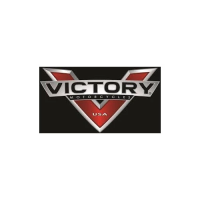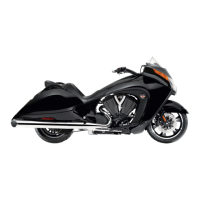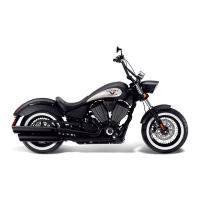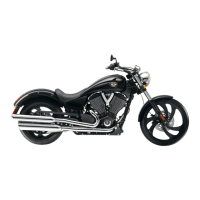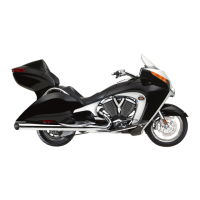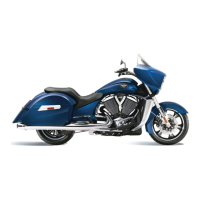Do you have a question about the Victory Kingpin and is the answer not in the manual?
Explains safety signal words and symbols used in the manual for user safety.
Provides essential guidelines for operating the motorcycle safely.
Details recommended protective gear for riders to minimize injury risk.
Explains the combined weight limit for safe motorcycle operation.
Offers guidelines for safely attaching and distributing cargo on the motorcycle.
Provides instructions on how to safely park the motorcycle.
Guides owners on how to report vehicle defects to authorities.
Identifies components on the handlebar area for VEGAS models.
Identifies components located on the left side of VEGAS models.
Identifies components located on the right side of VEGAS models.
Explains the location and importance of the VIN for the motorcycle.
Details the operation of the motorcycle's ignition switch.
Describes the speedometer, odometer, and trip odometer functions.
Explains the meaning and function of various dashboard indicator lights.
Details the functions of controls on the left handlebar.
Details the functions of controls on the right handlebar.
Guides on checking all electrical systems before riding.
Provides instructions for checking tire pressure, condition, and tread depth.
Details procedures for checking brake lever movement and fluid levels.
Explains how to check the mechanical and hydraulic clutch fluid levels.
Guides on inspecting the front suspension and steering operation.
Outlines the special procedures for the first 500 miles of operation.
Provides step-by-step instructions for starting the motorcycle engine.
Explains the correct procedure for shifting gears for optimal performance.
Details safe and effective braking techniques for various conditions.
Provides instructions on how to safely park the motorcycle.
Outlines the recommended schedule for regular motorcycle maintenance.
Details procedures for changing engine oil and oil filter.
Provides guidance on checking drive belt condition and tension.
Explains how to properly align the rear wheel for optimal performance.
Covers inspection and adjustment of rear shock absorber preload.
Details procedures for checking tire pressure, condition, and tread depth.
Provides information on battery care, charging, and installation.
Explains how to inspect and replace fuses in the motorcycle's electrical system.
Offers general advice for cleaning the motorcycle to protect its finish.
Details the steps for washing and drying the motorcycle safely.
Guides on how to wax, polish, and apply protectants to motorcycle components.
Provides guidelines for selecting and preparing a suitable storage location.
Details steps for preparing the motorcycle for storage, including fuel and oil.
Outlines the procedure for safely preparing the motorcycle after storage.
Explains federal laws regarding tampering with noise control systems.
Details the warranty coverage for the motorcycle's emission control system.
Lists limitations and exclusions applicable to the motorcycle warranty.
Provides key physical dimensions for motorcycle models.
Details engine type, configuration, displacement, and other related specs.
Specifies the recommended fuel type and octane rating for the motorcycle.
Explains the location and importance of the Vehicle Identification Number (VIN).
Details the location and significance of the engine identification number.
Indicates the location of the motorcycle's model number.
Explains safety signal words and symbols used in the manual for user safety.
Provides essential guidelines for operating the motorcycle safely.
Details recommended protective gear for riders to minimize injury risk.
Explains the combined weight limit for safe motorcycle operation.
Offers guidelines for safely attaching and distributing cargo on the motorcycle.
Provides instructions on how to safely park the motorcycle.
Guides owners on how to report vehicle defects to authorities.
Identifies components on the handlebar area for VEGAS models.
Identifies components located on the left side of VEGAS models.
Identifies components located on the right side of VEGAS models.
Explains the location and importance of the VIN for the motorcycle.
Details the operation of the motorcycle's ignition switch.
Describes the speedometer, odometer, and trip odometer functions.
Explains the meaning and function of various dashboard indicator lights.
Details the functions of controls on the left handlebar.
Details the functions of controls on the right handlebar.
Guides on checking all electrical systems before riding.
Provides instructions for checking tire pressure, condition, and tread depth.
Details procedures for checking brake lever movement and fluid levels.
Explains how to check the mechanical and hydraulic clutch fluid levels.
Guides on inspecting the front suspension and steering operation.
Outlines the special procedures for the first 500 miles of operation.
Provides step-by-step instructions for starting the motorcycle engine.
Explains the correct procedure for shifting gears for optimal performance.
Details safe and effective braking techniques for various conditions.
Provides instructions on how to safely park the motorcycle.
Outlines the recommended schedule for regular motorcycle maintenance.
Details procedures for changing engine oil and oil filter.
Provides guidance on checking drive belt condition and tension.
Explains how to properly align the rear wheel for optimal performance.
Covers inspection and adjustment of rear shock absorber preload.
Details procedures for checking tire pressure, condition, and tread depth.
Provides information on battery care, charging, and installation.
Explains how to inspect and replace fuses in the motorcycle's electrical system.
Offers general advice for cleaning the motorcycle to protect its finish.
Details the steps for washing and drying the motorcycle safely.
Guides on how to wax, polish, and apply protectants to motorcycle components.
Provides guidelines for selecting and preparing a suitable storage location.
Details steps for preparing the motorcycle for storage, including fuel and oil.
Outlines the procedure for safely preparing the motorcycle after storage.
Explains federal laws regarding tampering with noise control systems.
Details the warranty coverage for the motorcycle's emission control system.
Lists limitations and exclusions applicable to the motorcycle warranty.
Provides key physical dimensions for motorcycle models.
Details engine type, configuration, displacement, and other related specs.
Specifies the recommended fuel type and octane rating for the motorcycle.
Explains the location and importance of the Vehicle Identification Number (VIN).
Details the location and significance of the engine identification number.
Indicates the location of the motorcycle's model number.
| Displacement | 1731 cc |
|---|---|
| Cooling System | Air / oil |
| Fuel System | Electronic Fuel Injection with dual 45mm throttle bodies |
| Transmission | 6-speed overdrive constant mesh |
| Final Drive | Carbon fiber reinforced belt |
| Fuel Capacity | 4.5 gallons |
| Seat Height | 26.5 inches |
| Wheelbase | 65.7 inches |
| Engine Type | 50° V-Twin |
| Horsepower | 92 hp |
| Torque | 109 ft-lbs |
| Front Suspension | Telescopic fork |
| Rear Brakes | 300mm floating rotor with 2-piston caliper |
| Front Tire | 130/70R18 |
